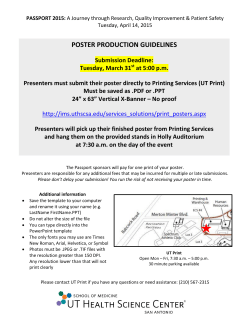
CV - Darko Odic - University of British Columbia
Darko Odic Contact Information Department of Psychology 2136 West Mall (Kenny Building) University of British Columbia Vancouver, BC, Canada, V6T 1Z4 Phone: (604) 827-0621 E-mail: darko.odic@psych.ubc.ca Web: odic.psych.ubc.ca Last Updated: February 25, 2015 Research Interests Cognitive development, number and quantity perception, interface of vision and language, confidence representations, psychophysics, language acquisition. Employment University of British Columbia, Vancouver, British Columbia, Canada Assistant Professor, Department of Psychology, July 2014 - present. Education Johns Hopkins University, Baltimore, Maryland, USA Ph.D., Psychology, May 2010 - June 2014. M.A., Psychology, September 2009 - May 2010. • Advisor: Justin Halberda • Thesis: Objects and Substances in Vision, Language, and Development University of Toronto, Toronto, Ontario, Canada Hon. B.S., Psychology, September 2004 - May 2008. • Advisors: Jay Pratt and Lynn Hasher • Honour’s Thesis: The effects of aging on the attentional blink Publications Libertus, M., Odic, D., Feigenson, L., and Halberda, J. (in press) A developmental vocabulary assessment for parents (DVAP): validating parental report of vocabulary size in 2-7 year-old children. Journal of Cognition and Development. Odic, D., Le Corre, M., and Halberda, J. (2015) Children’s mappings between number words and the approximate number system. Cognition. 138, 102-121. Halberda, J., and Odic, D. (2014) The precision and internal confidence of our approximate number thoughts. In D. C. Geary, D. Berch, & K. Koepke (Eds.) Evolutionary Origins and Early Development of Basic Number Processing (p. 305-333). Academic Press. Odic, D., Hock, H., and Halberda, J. (2014) Hysteresis affects approximate number discrimination in young children. Journal of Experimental Psychology: General, 143(1), 255-265. Odic, D., Libertus, M., Feigenson, L., and Halberda, J. (2013) Developmental change in the acuity of approximating area and approximating number. Developmental Psychology, 49, 1103-1112. Odic, D., Pietroski, P., Hunter, T., Lidz, J., and Halberda, J. (2013) Childrens understanding of ’more’ and discrimination of number and surface area. Journal of Experimental Psychology: Learning, Memory, and Cognition, 39, 451-461. Libertus, M., Odic, D., and Halberda, J. (2012) Intuitive sense of number correlates with scores on college-entrance examination. Acta Psychologica, 141, 373-379. 1 Odic, D., Roth, O., and Flombaum, J. (2012) The relationship between apparent motion and object files. Visual Cognition, 20 , 1082-1094. Pietroski, P., Lidz, J., Hunter, T., Odic, D., and Halberda, J. (2011) Seeing what you mean, mostly. Syntax & Semantics, 37, 181-218. Odic, D., and Pratt, J. (2010). Differential activation theory can account for the Ternus display: Rejoinder to Petersik. Perception, 39 (5), 711-717. Odic, D., and Pratt, J. (2008). Solving the correspondence problem within the Ternus display: The differential-activation theory. Perception, 37(12), 1790 - 1804. Papers under review Odic, D., Im, H.Y., Eisenger, R., Ly, R., and Halberda, J. (under review) PsiMLE: A maximumlikelihood approach to estimating psychophysical scaling and variability more reliably, efficiently, and flexibly. Shusterman, A., Slusser, E., Odic, D., and Halberda, J. (under review) Connecting early number word knowledge and approximate number acuity. Papers in preparation (available with request) Odic, D., Pietroski, P., Lidz, J., and Halberda, J. (in prep) The co-development of language and cognition: evidence from childrens acquisition of most. Odic, D. and Halberda, J. (in prep) Eye-Tracking Signatures Differentiate Number from Cumulative Surface Area Encoding. Odic, D., Libertus, M., Zhu, R., Feigenson, L., and Halberda, J. (in prep) The relationship between verbal number estimation and the Approximate Number System in five- to seven-year-old children and adults. Libertus, M., Odic, D., Feigenson, L., and Halberda, J. (in prep) Verbal number estimation predicts math ability and mediates the relation between numerical approximation and math ability. Wang, J., Odic, D., Halberda, J., and Feigenson, L. (in prep) A temporary change in numerical approximation precision improves symbolic mathematics performance. Odic, D., Pietroski, P., Hunter, T., Lidz, J., and Halberda, J. (under revision) Interface transparency and the count/mass distinction. Talks Halberda, J., Libertus M., Wang, J., Odic, D., and Feigenson, L.(2013) Intervention and Transfer in the Approximate Number System (ANS) Talk presented at CDS 2013, Memphis, TN. Odic, D., and Halberda, J. (2013) The Independence of Visual Number and Area Processing: Evidence from Psychophysics, Development, and Eye-Tracking. Talk at VSS 2013, Naples, Florida. Wellwood, A., Halberda, J., Hunter, T., Odic, D., Pietroski, P., and Lidz, J. (2012) Meaning more or most: evidence from 3-year-olds. Talk and Proceedings at Chicago Lingusitics Society 2012, Chicago. Wellwood, A., Odic, D., Halberda, J., and Lidz, J. (2012) Choosing quantity over quality: syntax guides interpretive preferences for novel superlatives. Talk and Proceedings at Cog Sci 2012, Japan. Peer-Reviewed Conference Posters Odic, D., and Halberda, J. (2013) Visual magnitude comparison is massively parallel for objects and ensembles. Poster presented at OPAM 2013, Toronto, Canada. 2 Odic, D., Libertus, M., Feigenson, L., and Halberda, J. (2013) Quantity of Quantity: are visual area and number represented by one systems, or two?.Poster presented at SRCD 2013, Seattle. Odic, D., Wellwood, A., Pietroski, P., Lidz, J., Hunter, T., and Halberda, J. (2013) How word meanings interface with cognition: a case-study of children’s acquisition of most.Poster presented at SRCD 2013, Seattle. Odic, D., Libertus, M., Feigenson, L., and Halberda, J. (2012) Developmental change in the acuity of approximating area and approximating number. Poster presented at ICIS 2012, Minnesotta. Odic, D. and Halberda, J. (2012) Representations of Difficulty and Confidence in Numerical Discrimination. Poster presented at VSS 2012, Naples, Florida. Odic, D., Libertus, M., Feigenson, L., and Halberda, J. (2012) Developmental change in the acuity of approximating area and approximating number. Poster presented at ICIS 2012, Minneapolis. Odic, D., Hock, H., and Halberda, J. (2011) The effect of confidence hysteresis on numerical perception and decision making. Poster presented at Cog Sci 2011, Boston, Mass. Odic, D., Hock, H., and Halberda, J. (2011) The effect of confidence hysteresis on numerical discrimination. Poster presented at VSS 2011, Naples, Florida. Roth, O., Odic, D., and Flombaum, J. (2011) The interaction of apparent motion and object files. Poster presented at VSS 2011, Naples, Florida. Odic, D., Hunter, T., Pietroski, P., Lidz, J., and Halberda, J. (2011) Childrens understanding of mass-noun more. Poster presented at 2011 SRCD conference in Montreal, Canada. Libertus, M., Stevenson, A., Odic, D., Feigenson, L., and Halberda, J. (2011) The developmental vocabulary assessment for parents (DVAP): a novel tool to measure vocabulary size in 3-5 year olds. Poster presented at 2011 SRCD conference in Montreal, Canada. Shusterman, A., Slusser, E., Odic, D., and Halberda, J. (2011) Connecting early number word knowledge and approximate number acuity. Poster presented at 2011 SRCD conference in Montreal, Canada. Odic, D., Ly, R., Hunter, T., Pietroski, P., Lidz, J., and Halberda, J. (2010) Number and area discrimination engage similar representations: evidence from discrimination tasks. Poster presented at 2010 VSS conference in Naples, Florida. Halberda, J., Le Corre, M., Odic, D., and Stevenson, A. (2010) Young childrens mapping between exact and approximate meanings for number words. Poster presented at the 2010 ISIS conference in Baltimore, Maryland. Grants University of British Columbia Hampton Research Endowment Fund (PI) October 2014 - 2016 ”The psychology and psychophysics of confidence” $10,000. Teaching Introduction to Psychology (UBC) January 2015 Freshman-level course covering Intelligence, Personality, Emotion, Motivation, Social, Health, Developmental, and Clinical Psychology. Psychology of the Unscientific (JHU) January 2013, 2014 Independently developed and lectured a 18 hour intensive course on how psychologists study con- 3 sciousness, free will, ESP, dreams, art, and religion. Course evaluations for both 2013 and 2014 available upon request. Honours and Awards Johns Hopkins G. Stanley Hall Excellence in Research Award (2013) Natural Sciences and Engineering Research Council of Canada Alexander Bell PGS-D (2010) Natural Sciences and Engineering Research Council of Canada Alexander Bell PGS-M (2009) Natural Sciences and Engineering Research Council of Canada Alexander Bell CGS-M (declined) University of Toronto Excellence in Natural Sciences and Engineering Award (2008) University of Toronto Excellence in Natural Sciences and Engineering Award (2007) University of Toronto Excellence in Natural Sciences and Engineering Award (2006) 4
© Copyright 2025










